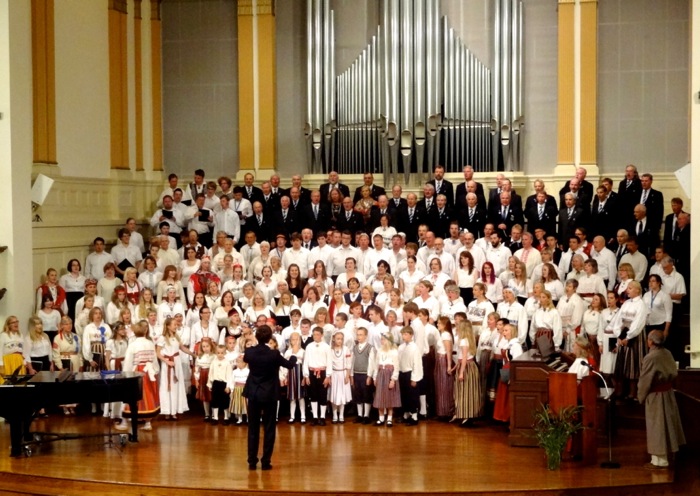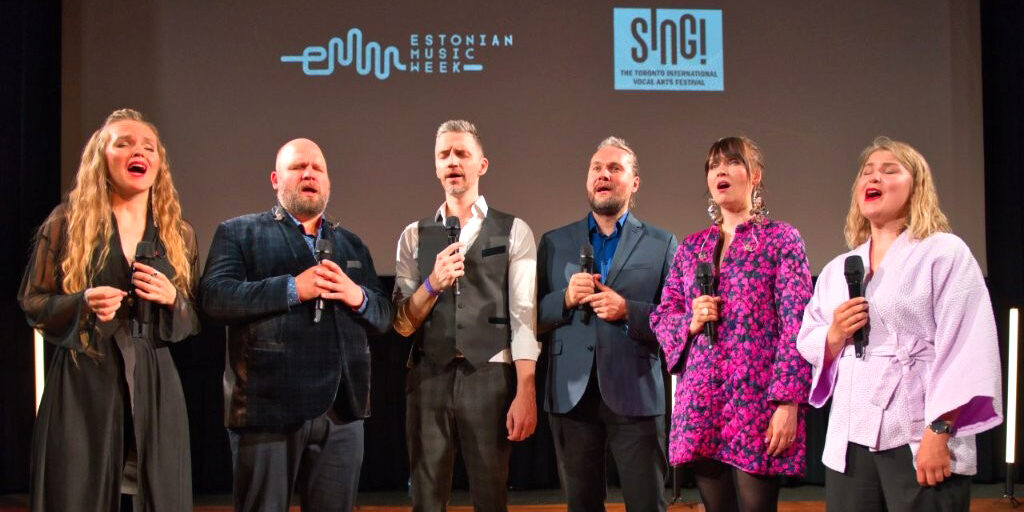And this in spite of unique features at LEP-ESTO, such as the fantastic ballet performance at the opening gala.
Contemplating the purpose of attending both events, I realized that both were umbilical connections to being a global Estonian. The main task for many of us from the Toronto choral scene was also to make a contribution to Estonian music. And in terms of family groups coming to the west coast, we wanted our sons and daughters to be more aware of all this.
Within the four-day LEP-ESTO (The West Coast Estonian Days and Worldwide ESTO Festival), it became obvious that the song festival concert was at the heart of the event. With all the heartfelt beauty that this entails, the well-known conductor-composer Roman Toi likes to call this traditional event ESTO's Christmas Tree.
The united choral concert at the huge Calvary Presbyterian Church was extremely well-organized, tight and entertaining, yet in many ways similar to the outdoor concert at Seedrioru. A quick comparison reveals the following similarities in the programme: total songs at Frisco, including solo choir performances (not including anthems) – twenty. At Seedrioru there were 19. Of the mixed or united choir renditions, Seedrioru had 13 while ESTO had 11, while sharing five.
Common to both events was the European Choir of Estonians – a 35-member representation of a 160-strong chorus from 14 different European countries which dominated at the Seedrioru Festival and were still a presence in San Francisco, being one of the few solo choirs.
Emerging as a vivid personality at both locations was the conductor of the European Choir. Kalev Lindal's energy, devotion and humour are described as the driving force behind this composite group. Kalev reinforced his North American choral contingent with male singers from Estonia, mainly from his own choir, in order to balance the European mixed voices in Seedrioru and San Francisco.
Balancing the sound of the united voices at the ESTO concert were over thirty male choristers who had crossed the ocean under the auspices of the Estonian Male Choral Federation (Eesti Meestelaulu Selts) led by Arvi Karotam and conductor Jüri Rent in collaboration with the LEP-ESTO Songfest co-ordinator Saima Kint.
As common denominators in the most concrete form were the conductors who came to both events. At Seedrioru, where the festival was led by the symphony conductor Norman Reintamm, we sang, among others, under the direct guidance of Charles Kipper, Kalev Lindal and Ingrid Silm. These same three starred as well at the ESTO concert. While Kalev was spared the mass choir conducting duties at LEP-ESTO, he acted as dramatic poetic announcer in partnership with the more businesslike Saima Kint.
It is time we left the choral scene and chose other paths to tread. Or should I say dance? Seedrioru is well suited for physical movement where I remember seeing the Kalev Gymnastic Club Folk Dance Troupe performing 50 years ago. At the Seedrioru ,,Laulupäev” a few weeks ago I enjoyed an energized Kungla dance team from Toronto give a performance that had me cheering in the middle of it. Well, the same group performed at LEP-ESTO, along with a co-ordinated artistic assembly from Estonian global communities, particularly from Estonia. The Dance Fest was called ,,Estonia Without Borders” and brought the public from hotels and pavement onto well-maintained green grass reminiscent of Seedrioru. Instead of tall trees, of course, we had to contemplate tall buildings beyond the confines of Yerba Buena Gardens in the heart of the city.
Shall we denominate some more? Let's talk about nature. That's what Seedrioru is all about – a beautiful valley characterized by cedars and the Grand River. A dose of Seedrioru, imbued with traditional choral music and a healthy shot of folkdance envigorates the Estonian psyche for the midnight drive back to Toronto and beyond. The call of the wild at LEP-ESTO came from the torrid California interior, where the grass is a burnt brown and the trees not particularly populous. Yes, the ,,rahvapidu” or the closing party under the moniker ,,Folk Picnic” was held in the sun-heated outdoors. But it was in nature and we all loved it, particularly the young and athletic. The place was called Castle Rock Park, located in Walnut Creek, 30 miles from downtown SF. The return trip across the bay provided unforgettable vistas.
As Estonian functions close, a certain song is often sung. “The Wheel of Time goes round and round”. This was the traditional closing choral piece at the Seedrioru Song Festival concert. In beautiful harmony. At the Folk Picnic, following the Ceremony of the Flags denoting the next Big Festivals (Vancouver and Toronto), as we formed the traditional Circle of Friendship, Ingrid Echter, the head of LEP-ESTO called out: “Does anyone know Ajaratas (Wheel of Time)?” Silence. Most of the choristers had gone. I noticed conductor Charles Kipper beyond the crowd, seeking relief from the heat, and persuaded him to step forward. The hero of the day thus not only conducted and sang but also recited the words for the Estos, eager to sing but suddenly wordless in song. Thanks to Charles, a tradition was maintained!
A thorough comparison of the two cultural events would not have been logical and was not the intent of this article. The four-day LEP-ESTO with its various venues contained so much more than a one-day event at could ever hold – seminars, golf, theatre, ballet, films, formal ball, meetings and a beautiful church service. And talent from Estonia that could fill yet more articles and reports. But the total numbers are comparable, with well over half ESTO's number of choral voices singing at Seedrioru. Naturally enough, total attendance at the West Coast-World festival was double. Both events almost share a date of inception – West Coast Festivals began in 1953 while the first Song Festival at Seedrioru occurred in 1956.
But the principal common concept crystallizing at both events was the youth card. While events at Seedrioru are already being run and attended by a new generation, LEP-ESTO was organized by an even more youthful new team, many having arrived from Estonia only 10 – 15 years ago. The main common denominator? The future!
Andres Raudsepp




